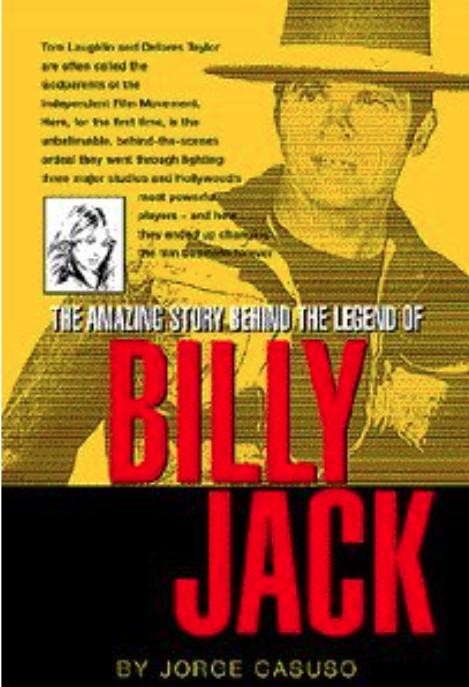 By JORGE CASUSO (Billyjack.com; 1999)
By JORGE CASUSO (Billyjack.com; 1999)
It’s an interesting thing about this, the first and only book about the BILLY JACK movie phenomenon and its late originator Tom Laughlin (1931-2013): it’s painfully limited in scope yet pretty much says all that need be said. In other words, the book is an unabashed puff piece that still manages to satisfy, emerging as the definitive resource on all things BILLY JACK.
Published by Laughlin himself (and taking the form of many a self-published tome in the pre-Lulu.com era: a collection of spiral-bound Xeroxed sheets), THE AMAZING STORY BEHIND THE LEGEND OF BILLY JACK is everything you’d expect from a man whose ego was his defining trait. That’s despite the fact that it was written by Jorge Casuso, who turned out a furiously readable text that was informed entirely by the thoughts and recollections of Mr. Laughlin—who in these pages comes off as a combination of Gandhi and Orson Wells (his longtime spouse and BILLY JACK co-star Delores Taylor also gets some coverage, but it’s Laughlin who receives front-and-center placement).
According to this book, Laughlin was driven by a mania for social justice, especially in regard to Native Americans. He scripted BILLY JACK after a 1953 encounter in Prescott, Arizona, where Laughlin, then an aspiring actor on his way to Hollywood, was made privy to the hardships faced by American Indians. It took 17 years for BILLY JACK to be put into production, with Laughlin becoming a prolific supporting actor whose credits included GIDGET (1959), the TV series WAGON TRAIN and THE DELINQUENTS (1957), an early directorial credit by Robert Altman (who Laughlin dismisses in these pages as a “prima donna”).
The turning point came when Laughlin wrote, directed and starred in the action-oriented indie BORN LOSERS (1967), in which the character of Billy Jack was first introduced. It was a massive hit, and led directly to BILLY JACK (1971), whose production travails are voluminously documented by Casuso.
The film, it seems, was shepherded by, and bounced from, no less than three studios—American International Pictures, 20th Century Fox and Warner Brothers—before being self-distributed by Laughlin, in which form it became the highest grossing independent film of its time. Truthfully I’ve never understood the appeal of BILLY JACK, about a Native American tough guy (played by the very Caucasian Laughlin) who advocates for peace while kicking lots of ass. Still, I can’t argue with success, which according to this book involved a fan approaching Laughlin and Taylor to “thank you for my life,” apparently “a line Tom and Delores had often heard before.”
That success, alas, proved detrimental to a man whose sense of self-importance was highly inflated to begin with. THE TRIAL OF BILLY JACK (1974) was an agonizingly self-indulgent mess, with Laughlin’s promotional antics being more entertaining than the film itself. Those antics included opening the film on 1,200 screens across the country (in defiance of Hollywood’s seventies-era leveraged distribution pattern) and holding an essay contest to answer why the opinions of film critics were so divergent from those of paying audiences (never mind that Laughlin himself admitted THE TRIAL OF BILLY JACK was heavily flawed).
From there Laughlin was, in the words of the late Samuel Z. Arkoff, “Destroyed by his own ego.” Casuso, of course, has a different view, claiming Laughlin was simply too radical for Hollywood. THE MASTER GUNFIGHTER (1975), a sluggish attempt at transplanting the BILLY JACK formula to an old west setting, was a flop, and BILLY JACK GOES TO WASHINGTON (1977), a remake of MR. SMITH GOES TO WASHINGTON with BJ in the main role, was never released, apparently because the Washington establishment found it too threatening (and the fact that it was a lousy movie). A similar fate befell THE RETURN OF BILLY JACK (1986), although that film goes unmentioned in this book.
In closing I’ll admit that, despite my admonitions, I respect Tom Laughlin greatly. A borderline lunatic he may have been, but his innovations and outside-the-box thinking are laudable. I also respect THE AMAZING STORY OF BILLY JACK, which in its unabashed puffery gives Laughlin’s resourcefulness a righteous tribute, while in letting its subject speak for himself provides a more damning indictment of his failings than any scholarly dissertation could hope to offer.
